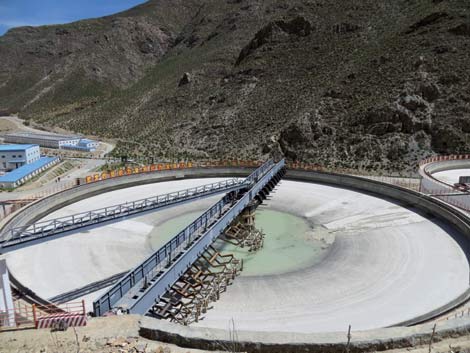Mining projects
|
 |
|
Huatailong's mining project in Jiama town, Metrorkongka county, 68 kilometers from the center of Lhasa. China Gold, the only central State-owned enterprise in the gold industry in the country, now owns the Jiama mine. [Photo / China Daily] |
"I used to be snubbed by my fellow villagers because I helped people from the inland to explore the mining resources in the region," said Lukhang Yeshe when being asked about the difficulties of his job.
He started by acting as an interpreter of the Tibetan language for Mandarin speakers in 2008 and is now the general manager's assistant at Huatailong.
He said the area has a 15-year history of mining and there were mainly private companies in the area before China Gold came in 2008. The private mining companies were not well regulated and disputes often erupted among the local people over the deaths of yaks that drank polluted water and the reduction in grassland.
The regional government asked State-owned companies to begin mining and associated development there during the 11th Five-Year Plan (2006-10). The aim was to develop the mining resources scientifically with advanced technology and protect the fragile natural environment on the plateau at the same time.
Huatailong was officially established in December 2007 in Tibet by its parent company, China Gold, on such an understanding.
After 40 separate negotiations over six months between Huatailong and other companies in the Jiama area, the company succeeded in acquiring four mining rights, five exploration rights and eight mines in a total area of 144 square kilometers in July 2008.
"I believe that the participation of a State-owned company in the mining industry in Tibet is beneficial and meaningful to the place because the company has the responsibility and financial strength to protect the natural environment at such a high altitude, something that requires huge investment," said Lukhang Yeshe.
After two years of construction, the first phrase of the Jiama project started production in July 2010 and realized revenues of 150 million yuan in the same year.
Over the past three years, the company has spent 252 million yuan in total on prospecting for minerals, discovering proven copper reserves in the area of 6.2 million tons from proven reserves in 2007 of 930,000 tons. Meanwhile, the company discovered 650,000 tons of molybdenum reserves, 140 tons of gold reserves, 8,624 tons of silver reserves and 560,000 tons of lead and zinc reserves.
At present, 40 drilling machines are being used to explore for more resources. Industry experts believe the overall mining resources in Jiama will together be equal to more than 20 million tons of copper in terms of value.
